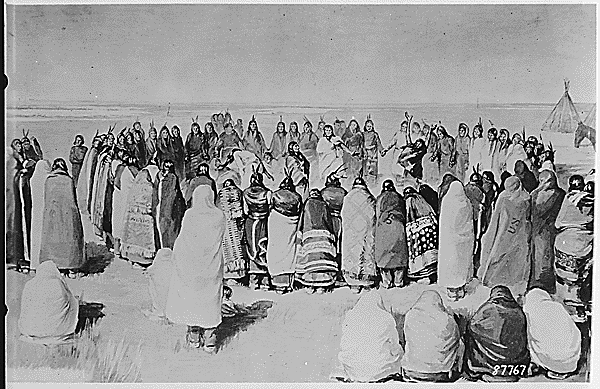PTSD and other disorders that result from historical horrors (wars, slavery, etc.) seem to be intergenerational not just because of nurture but due to nature as well, with the hormone cortisol playing a significant role in perpetuating the pain. So, it’s not just the ghosts making mayhem but also a heritable biological reordering which victims unknowingly pass on to descendants. Can this phenomenon be neutralized? From “The Science of Suffering,” by Judith Shulevitz at The New Republic:
“In the early ’80s, a Lakota professor of social work named Maria Yellow Horse Brave Heart coined the phrase ‘historical trauma.’ What she meant was ‘the cumulative emotional and psychological wounding over the lifespan and across generations.’ Another phrase she used was ‘soul wound.’ The wounding of the Native American soul, of course, went on for more than 500 years by way of massacres, land theft, displacement, enslavement, then—well into the twentieth century—the removal of Native American children from their families to what were known as Indian residential schools. These were grim, Dickensian places where some children died in tuberculosis epidemics and others were shackled to beds, beaten, and raped.
Brave Heart did her most important research near the Pine Ridge Reservation in South Dakota, the home of Oglala Lakota and the site of some of the most notorious events in Native American martyrology. In 1890, the most famous of the Ghost Dances that swept the Great Plains took place in Pine Ridge. We might call the Ghost Dances a millenarian movement; its prophet claimed that, if the Indians danced, God would sweep away their present woes and unite the living and the dead. The Bureau of Indian Affairs, however, took the dances at Pine Ridge as acts of aggression and brought in troops who killed the chief, Sitting Bull, and chased the fleeing Lakota to the banks of Wounded Knee Creek, where they slaughtered hundreds and threw their bodies in mass graves. (Wounded Knee also gave its name to the protest of 1973 that brought national attention to the American Indian Movement.) Afterward, survivors couldn’t mourn their dead because the federal government had outlawed Indian religious ceremonies. The whites thought they were civilizing the savages.
Today, the Pine Ridge Reservation is one of the poorest spots in the United States. According to census data, annual income per capita in the largest county on the reservation hovers around $9,000. Almost a quarter of all adults there who are classified as being in the labor force are unemployed. (Bureau of Indian Affairs figures are darker; they estimate that only 37 percent of all local Native American adults are employed.) According to a health data research center at the University of Washington, life expectancy for men in the county ranks in the lowest 10 percent of all American counties; for women, it’s in the bottom quartile. In a now classic 1946 study of Lakota children from Pine Ridge, the anthropologist Gordon Macgregor identified some predominant features of their personalities: numbness, sadness, inhibition, anxiety, hypervigilance, a not-unreasonable sense that the outside world was implacably hostile. They ruminated on death and dead relatives. Decades later, Mary Crow Dog, a Lakota woman, wrote a memoir in which she cited nightmares of slaughters past that sound almost like forms of collective memory: ‘In my dream I had been going back into another life,” she wrote. “I saw tipis and Indians camping … and then, suddenly, I saw white soldiers riding into camp, killing women and children, raping, cutting throats. It was so real … sights I did not want to see, but had to see against my will; the screaming of children that I did not want to hear. … And the only thing I could do was cry. … For a long time after that dream, I felt depressed, as if all life had been drained from me.’
Brave Heart’s subjects were mainly Lakota social-service providers and community leaders, all of them high-functioning and employed. The vast majority had lived on the reservation at some point in their lives, and evinced symptoms of what she called unmourned loss. Eighty-one percent had drinking problems. Survivor guilt was widespread. In a study of a similar population, many spoke about early deaths in the family from heart disease and high rates of asthma. Some of her subjects had hypertension. They harbored thoughts of suicide and identified intensely with the dead.”

